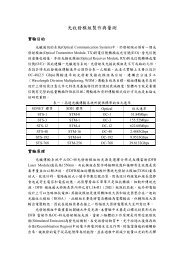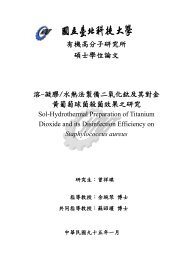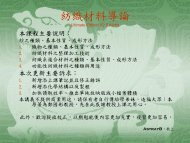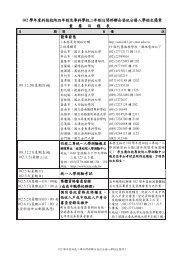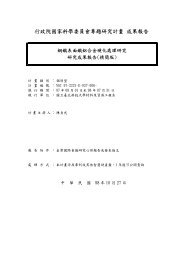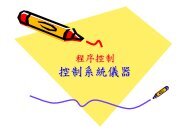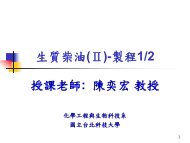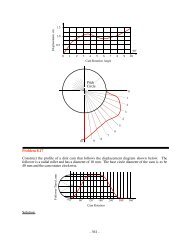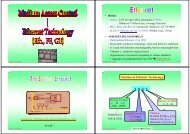è¡æ¿é¢å家ç§å¸å§å¡æè£å©å°é¡ç 究è¨ç« ææå ±å æä¸é²åº¦å ±å èªç¼ ...
è¡æ¿é¢å家ç§å¸å§å¡æè£å©å°é¡ç 究è¨ç« ææå ±å æä¸é²åº¦å ±å èªç¼ ...
è¡æ¿é¢å家ç§å¸å§å¡æè£å©å°é¡ç 究è¨ç« ææå ±å æä¸é²åº¦å ±å èªç¼ ...
You also want an ePaper? Increase the reach of your titles
YUMPU automatically turns print PDFs into web optimized ePapers that Google loves.
The difference in viscosity between twoindividual polymers for producing abicomponent fiber can cause seriously migrateand deform the interface (16, 17). When twocomponents, with equal throughput, are extrudedusing the same spinnerette, the higher-viscositycomponent inclines to occupy over half of thecross-sectional area to equalize the pressure drop.Consequently, dog-legging, or even worse, abroken filament occurs. The search forprocessing conditions under which viscosities ofthe two components are identical or very closethus is critical to conjugated spinning, especiallyfor side-by-side products.Figures 2(a) to (d) illustrate thedependence of viscosity on shear rate forprocessing PET and CD, PBT, and PTT,respectively, at various temperatures. Theprocessing temperature of PET must be 20 to 30degrees higher than that of PTT and PBT toachieve the same melt viscosity. Notably, thistemperature difference might be offset as twopolymer merge together at the final section ofthe spinnerette. Since the residence time via themerged section is too short to even up thetemperature differences, the merged section wasassumed not to cause further viscosity difference.Figures 3 (a) to (d) show a series of PET/PBTconjugated spinning under different spinningconditions, where the spinning temperature wasmaintained at 290 o C for PET but was variedfrom 250 to 265 o C for PBT. The curvedinterface occurred in all the conditions except for3(c). This result agrees well with Figures 2 (a) (c)which illustrated a minimum difference inviscosity using the combination of PET/PBT290 o C/255 o C (Fig. 4). The curved interfaceindicates an unbalanced pressure inside thespinnerette, the low-viscosity melt was pushed tooccupy the high shear rate zone around thecapillary wall. Generally, the formation ofcrimps in a skein is more difficult for a curvedinterface than a straight interface. Moreover andmore seriously, a curved interface implies theoccurrence of a serious dog-legging problemwhich would deter and even stop the spinning.To prevent the formation of a curved interface,melt spinning for each condition here wasperformed to minimize the difference betweenthe melt viscosities of two sides via temperatureadjustment.Crimp InvestigationFigure 5 represents the effect of thecross-sectional shape on crimp potential. Theresults indicate that, in the same cross-sectionalarea, the triangular shapes are superior to theround cross section. The calculation, derivedfrom classical mechanics (18), reveals that thefirst momentμ 1 and second moment I 0 for roundshape and triangle shape are 0.405 r, 0.39 r 4 and0.483 r, 0.235 r 4 respectively. Based on Eqn. (1),the crimp curvature of triangular shape is astwice as that of round shape. This theoreticalcalculation agrees well with the experimentalresults. Furthermore, Fig. 5 demonstrates that theone in a triangular shape with higher shrinkagecomponent on the top, denoted as “the regulartriangle”, exhibits greater crimp curvature thanthe other triangle with reversed order, denoted as“the reversed triangle”.Figure 6 illustrates the influence of thevolume ratio of two components on the crimpcurvature. The optimal CP% generally occurredwith a ratio of 50/50. It can be concluded that theoptimal self-crimp can be achieved at the ratioaround 50/50 and is independent of thecombination of different components. Figure 7illustrates a series of photos of the cross sectionfor PET/PBT bicomponent fibers in variousvolume ratios. Notably, Denton predicted thatthe optimal curvature for a round yarn wouldoccur in a 50/50 combination for a straightinterface and a 60/40 combination for a curvedinterface. From Figs 6 and 7, even when bothconditions are optimized, the 50/50 with straightinterface outperformed the 60/40 with a curvedinterface. In short, both theoretical andexperimental results indicate that the ratio forcreating a self-crimp bicomponent yarn is 50/50by volume.CONCLUSIONSIn this study, self-crimp polyester yarnswere manufactured using a conjugatedspinning process. A theoretical modelproposed by Denton was proved to be veryuseful for predicting crimp potential.Maintaining identical or very similar meltviscosities of the two components wasdemonstrated to be very critical for obtaining astraight interface and eliminating thedog-legging problem. Regarding to the thermaltreatment following melt spinning, a temperaturerange approximately 20 to 30 degrees higherthan the T g of the harder side within the fiber isidentified as the optimum condition.The crimp tests illustrate that the triangularshapes are found to be superior to the roundcross section. Furthermore, a triangular shapewith higher shrinkage component on the top,denoted as “the regular triangle”, exhibits greatercrimp curvature than the other triangle withreversed order, denoted as “the reversedtriangle”. The optimum volume ratio for makinga self-crimp bicomponent skein is 50/50.4



